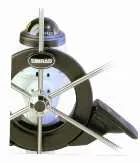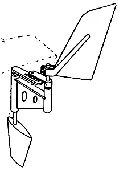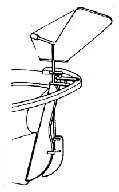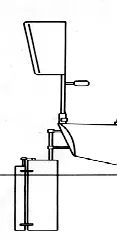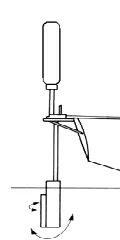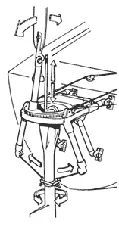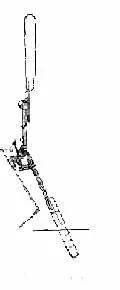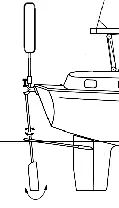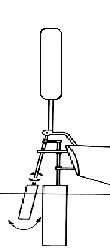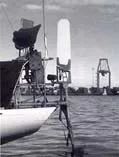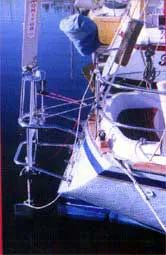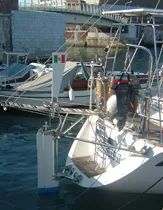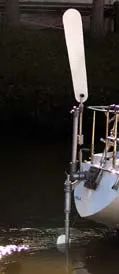Small Course in Selfsteering Systems
About Electronic Pilots and Windvane Self steering
What is best
An electronic pilot or the Self steering Windvane?
This compilation is aimed at enumerating the advantages and disadvantages of automatic pilots and of the Windvane Self steering. It also describes the way the Windvane Self steering works and also the reason why the latter ande the former are so important on board.
Autopilots
The major weakness with an autopilot is the battery on board and its capacity. What happens if the battery flattens out or if the engine will not start? Low consumption of energy is achieved when, by means of a compass, the vane assesses the course and the ship´s moments then it produces the electrical impulse necessary to steer the ship. This it does strongly and the smallest number of times as possible. The average working cicle in relation to the consumption of energy of different system is one of about 25 % of the total time. In one hour, the ship is steerless for the remaining 45 minutes.
Autopilots can be sampled into two
categories:
Tiler Autopilots. ,
They are connected directly to the helm or the rudder, they have got an inner or outer compass and their strength and performance are limited. They are designed for low energy consumption and they provide their in turn means a slow working speed.
Internal assembly Autopilots ,
They are fit up the rudders quadrant. They are designed for larger loads and they use up a great deal of energy. Electronic pilots can be connected to each other like navigation system units when, for instance, a certain course has to be kept. Energy consumption per hour in ampere may seem minimal; however, it turns out to be a considerable one in a 24-hour period. Consequently, it is obvious that when planning a cruise an analysis of the energy available is needed.
AutoPilot limitations: Due to its regular steering fashion, electronic pilots cannot perform well in bad weather. There is no autopilot which can adapt to weather changes. The only reliable signal transmitter in an electronic pilot is the compass, and that´s why most manufacturers have improved their developments regarding this feature, offering more often than not the so- called "gyrocompass" as an option: a saturation ordinary compass does not seem to be enough anymore.
The Windvane Self
steering
How does a windvane self-steering work
For those who sail offshore, the Windvane Self steering is a key element, just as the navigation charts and the compass are: they would never set off without it.
Vane over the tiller
This kind of Windvane, has the vane connected to the main rudder trough lines and works over the wheel or the tiller. It is but fair to say that these arrangements are inadequate and they do not work out. Bear in mind the very slight strength the weather vane yields and the large energy/vigour needed in order to overcome the resistance of the rudder. When the wind is weak, the vane is almost useless and can not overcome the friction in te system. This resistance increases as the wind blows harder. Although the vane not has more energy, it is still inadequate to surpass the rudder. The system fails because the vane does not have enough energy to control the course wich correct s the device, hereby the ships rudder.
Auxiliary rudder
systems
Here the vane not only has to provide the steering impulse, but also the strength to turn an auxiliary rudder. There fore, the vane is to be of a wide dimension. The main rudder is used for (the) precision calibrate and is afterwards blocked. In these system there is no servo_ strength support.
Servo- energy correction
system
Correcting the course by means of Servo- energy is a solution to the problem of the vanes limited energy, wich is amplified through an intermediate mechanism designed to increase the strength of the vane´s signal. This additional energy derives from the flow of water that is produced when the hull is in motion. The devices that create such "servo- energy" are: trim- tabs and servo- pendulums. The amplification the servo- shovels bring about is much greater that the strength they get from the vane. Those Windvanes which use servo- energy devices can be sorted out according to type of servo [and means by which they operate]
Trim Tab over Main
Rudder.
This type is often produced individually. As the main rudder is usually huge and hard to turn, the trim tab is comparatively large in order to be able to perform the task. Compared to the servo sistem: more is demanded from the vane and the trim- tab in this system, wich will not be able to steer the ship in eight wind or when there is strong resistance from the rudder. However, the introduction of the trim- tab allows for vane to manoeuvre the tiller. Though these system work, they do do with great constraints and it´s difficult for the operator to overcome the errors they fall into. It is very hard to steer a ship with non-compensated rudders and in bad weather conditions.
Trim tab over auxiliary Rudder
A small fletner is used to turn the auxiliary rudder, which is remarkably smaller than the main rudder. In terms of the area to be controlled, there is less demand on the vane. This is a more sensitive system than that in which the fletner is connected to the main rudder. Besides, the main rudder can now be used for better adjustment of the boat and the balance, while it makes the task easier for the Windvane. If there´s a slight breeze, this system is extremely sensitive, since it can not turn the ship´s own rudder (which is much larger). The system performs best on ships which are more than 45 feet in length, . as in bigger ships the auxiliary rudder can gradually become smaller. With larger ships auxiliary rudder systems often require to lock the (sailboat´s) tiller. They can not be removed at sea when they are not in use. They are preferred for ships with a poor main handling system.(They usually get stuck or prove to have excessive friction) They can be used as emergency rudders. The auxiliary rudder will also improve the directional stability for it is placed far astern.
Double Servo.
A double servo system windvane (rudder/ selfsteering). The aim is to improve the sensitivity and energy of the Windvane (Self steering/ rudder), providing the vane with more than one servo device. Navik´s Windvane Self steering is the only double- servo system which has been commercially manufactured and which has been sailed in huge numbers. In the Navik´s, a servo-oar is used to turn the ship´s main rudder. However, the vane does not control the servo-oar directly. Instead, the vane´s signal turns round a tiny trim-tab in the rear edge of the servo-oar, which then alternately forces the servo-oar to rotate. This trim-tab provides an increase of the energy used to control the servo- oar. There is less demand on the vane. It is used by smaller ships, within a range of 20 - 30 feet.
Servo pendulum systems,
With this type, the rudder shaft moves sideways (swing), depending on the vanes signal and also on the rudders position. The servo-forces here are usually enough to sail the main rudder of ships of up to 30 t (tons) safely. A proper transmission of the rudder is indispensable to this aim and steering through the tiller will be ideal. Wheel steering systems worsen the transmission of power; what´s more, they can render it impossible. The worse the power transmission, the faster the boat will (drift/sail) off- course.
Double rudder system,
The vane signal activates an servo- rudder which makes an auxiliary rudder turn with increased strength. Since it is independent from the main rudder, this system is suitable for huge yachts with central cockpit (those used at present to sail on the high seas).
Pendulum/ trim-tab over the
ship´s rudder.
The rig of the Saye´s is a unique windvane (selfsteering) patented [a hybrid pendulum trim-tab]. An arm from the shaft, that looks like a bolt of the hair that joins it, connected astern, to the rudder. This system is generally the ideal Windvane (Self steering) for huge ships which usually have hydraulic steering, central cockpit . An auxiliary rudder is frequently too small to control such large ships and, due to the hydraulic handling, a servo-pendulum can not be hooked down to the wheel (there are also many turns as there is rubbing in the system). Preferably, the ship´s design should be a conventional one, with its rudder astern. The longer the [connecting] arm, the more energy the servo oar will have.
Keys for the use of the Windvane Self
steering or of an electronic pilot
It´s not only the Windvane determines the proper steering.
The qualities of the ship and the crews experience also have a say in the outcome. [Since sailing boats are all different as to appearance, rigging, size, speed, performance, etc], it is obvious that the features of the yacht will influence its performance.
The very best performance of the Windvane Self steering requires a balanced ship. This is necessary for automatic pilots as well. Any steering system can be particularly affected by gross mistakes in the choice and adjustment of the sails.
Improper trimming of the boat can spoil the performance of even the best windvane. Balancing the ship for the windvane operation means trimming in such a way the ship will have a tendency to remain on the desired course.
If a waving movement or change in the strength of the wind drives the ship off-course, the adjustment of the balance ought to produce a tendency for the ship to return to the course on its own. In recent years have found that a typical mistake of sailors who use a windvane for the first time lies in the tendency of over- sailing the ship and of sailing [barcos ardientes].
Those who get results rapidly have spent some time balancing the boat so that the windvane want have to work necessarily. Although a good windvane can tolerate many mistakes, the best performance will be achieved when the windvane works only to make small corrections in order to keep the boat wheel balanced and on-course.
Most of the times, the inexperienced sailor with a new windvane on board will find that a little experience leads to great improvements.
The windvane will really teach him a lot about sailing and about how to adjust the ship.
Electronic Pilots:
Good compromise if you know and accept their limitations. Advantages while sailing with a running engine, for the ship can sail following the compass and energy consumption is not a problem with a running engine. Disadvantages while navigating with sails spread, for in this case navigation following the compass will not be profitable and the battery is used up. A long trip and bad sea conditions worsen the results of autopilots.
Windvane:
As long as the ship gets a forward push from its sails, the windvane will be a perfect steersman. Works better as weather conditions deteriorate. Its limitations: It has no eyes and can not read a gust of wind. It doesn´t work in calm weather either. Depending on their kind and on their handling such automatic steering systems can be suitable for weekend or holiday sailors, though they are usually used for long trips.
Summary.:
The combination of a small cockpit pilot and a windvane is in fact the ideal solution to deal with all kinds of steering problems, for in this case, the compass control drive reinforced through the strength of an oscillating rudder system so as to start a counter-rudder movement in the main rudder. The survey makes it plain that: Navigating under sail can be fun: it is the skipper itself (which is the ideal steersman) that steers the ship. If you spend more time at sea o r you long more comfort, an automatic pilot or windvane will be the ideal complement. But both are needed on long trips.
Advantages of the Electronic
Pilot.
" Invisible
" Compact
" Easy to handle
" Can be connected to the navigation system
" Reasonable price (cockpit pilots)
" Can be fixed under the engine
Disadvantages of electronic Pilots
" Navigation by compass is not ideal with sails spread.
" Use up energy
" Wind sensor is of little use (the vane sensor on the mast has to filter all the movements in order to send a legible signal)
" Works with command pauses (active only 15-20 min/ hour aprox.),
" Works noisily
" Reliability
" Limited life- Span " Works worse as surge increases
" More pressure on the main rudders bearings, for it is not flexible (compare: steersman who hold the tiller softly)
Advantages of the Windvane
" Steers in high tide and wind
" Does not consume energy
" More command strength as wind/ speed increases
" Steers without time delays
" Steers actively 60 min/ hour
" Steers noiselessly
" Mechanically reliable, tough building
" Auxiliary rudder = emergency rudder
" Almost unlimited lifespan
" Less load on the main rudder, since the system/ power transmission yields.
Disadvantages of the windvane
" Does not work in calm weather
" The [bathing gangway] has to be removed from its central
position,+
" It is not invisible
" It can be difficult to set up
South Atlantic re commends.:
A tiler autopilot: These can be fixed on to every South Atlantic windvane in order to steer the boat by means of a compass. The power is still provided by the servo-system and energy consumption is minimal. A sail boat of up to 25 t can be steered this way, with a minimum energy consumption.
This is the most suitable combination when there´s a light wind and the command signal is not reliable. As long as the movement of the sail boat along the water is enough to create the necessary servo strength this combination can be very advantageous.
The Windvane- Electronic Pilot allows for improvements in the performance of both systems.
If you require any further information , send us an e-mail with any questions you may have.
| Contact Us

